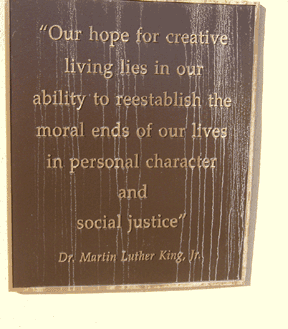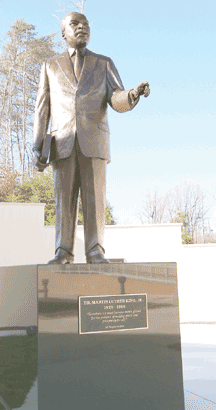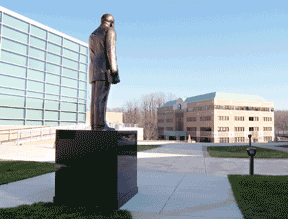|
|||
Keeping the Legacy Alive
|
 |
|
A nine-foot-six-inch tall statue of Dr. Martin Luther King Jr. overlooks the campus of Anne Arundel Community College. Five bronze plaques quote King’s speeches calling for equal opportunities in education and a just society. |
 |
Conceived and funded by the Dr. Martin Luther King Jr. Committee chaired by Anne Arundel activist Carl Snowden, the statue is also a monument to hundreds of people and organizations that contributed time, energy and the $400,000 to raise it.
The committee launched the fund-raising effort on August 28, 2005, and welcomed the memorial to the community with an outpouring of pleasure and pride less than one year later.
The statue honors Martin Luther King, which is the first thing we must ask a memorial to do. It honors us as well, to have him here among us.
To those who remember the living King marching, moving and speaking, Dwight’s statue is not a good likeness. Face and body seem stiff. King was a handsome man, but more so in motion than repose. The sculpture captures his imposing presence, but not his energy and passion.
Nor does the memorial honor King as a leader whose power came from the people he led. Millions marched for civil rights, yet this is a solitary King.
Still, King’s statue, according to Snowden, has a larger purpose.
“Dr. King was an individual that all races can learn from and benefit from. He was a giant in American history,” Snowden said.
The memorial is placed here because King staged many events in Maryland: He was in Baltimore before his “I Have a Dream” speech on the National Mall in 1963 — and had a huge impact on the state, said Snowden.
Another reason for building a memorial at this community college is to teach students that King stood for resolving conflicts without violence. The second part of the memorial will establish a Dr. Martin Luther King Jr. Institute of Non-violent Studies, where students will learn the techniques of resolving conflicts by non-violent means.
For now, the memorial isn’t well placed to be part of everyday life. We don’t see it while driving or walking; we must make a pilgrimage to the college to see it. Even at the school, this King is away from the center of college life. It stands a bit lonely, even when class is in session.
This may change in the future as these college buildings receive more use. The memorial will become a destination. January 15 will see a pilgrimage there, as 700 people attend the Dr. Martin Luther King Jr. annual breakfast at Anne Arundel Community College.
We build a memorial in the hope that it will keep the dust of disuse from obscuring the enduring contribution its hero made to our lives. We’ve all seen statues of generals, usually mounted, whose campaigns no longer stir our interest or even our memory. If this King — who made such a difference in our world, leading African Americans to full citizenship and awakening the consciences of us all — is to stir us, it will be by how this memorial is used. Through King’s quoted words, through events, through pilgrimages, through education, this memorial can live. Without these active remembrances, this memorial could become one more old statue.
I’m betting this won’t happen. Snowden’s words about teaching non-violent conflict resolution are encouraging. King believed that non-violent confrontation was the way to change the world. These are words and a philosophy not often heard. Even as the civil rights movement succeeded, King was mocked for his faith in non-violence, but succeed he did.
The changes King wrought and the ideas he expressed so eloquently will last — if we continue the struggle — and not by monuments alone.
Next Week: Thurgood Marshall, Alex Haley, Wiley Bates and Aris Allen Live Among Us as the Statues We Meet Each Day.
© COPYRIGHT 2004 by New Bay Enterprises, Inc. All rights reserved.


